Spatial and Temporal Assessment of Remotely Sensed Land Surface Temperature Variability in Afghanistan during 2000–2021
Abstract
:1. Introduction
2. Materials and Methods
2.1. Study Area
2.2. Data
2.2.1. Land Surface Temperature (LST) Data
2.2.2. Normalized Difference Vegetation Index (NDVI) Data
2.2.3. Precipitation Data
2.2.4. Soil Moisture Data
2.3. Standardized Anomaly Calculation
2.4. Margin of Error Calculation
3. Results
3.1. Seasonal and Annual Variations of LST
3.1.1. Seasonal and Annual Variations of LST over the Whole Afghanistan Area
3.1.2. Seasonal and Annual Variations of LST over the Afghanistan River Basins
3.2. Annual Variations of Precipitation and NDVI
3.3. Correlation of LST with Other Variables
4. Discussion
5. Conclusions
Author Contributions
Funding
Institutional Review Board Statement
Informed Consent Statement
Data Availability Statement
Conflicts of Interest
References
- Feng, Y.; Gao, C.; Tong, X.; Chen, S.; Lei, Z.; Wang, J. Spatial patterns of land surface temperature and their influencing factors: A case study in Suzhou, China. Remote Sens. 2019, 11, 182. [Google Scholar] [CrossRef] [Green Version]
- Reiners, P.; Asam, S.; Frey, C.; Holzwarth, S.; Bachmann, M.; Sobrino, J.; Göttsche, F.-M.; Bendix, J.; Kuenzer, C. Validation of AVHRR Land Surface Temperature with MODIS and in situ LST—A timeline thematic processor. Remote Sens. 2021, 13, 3473. [Google Scholar] [CrossRef]
- O’Connor, B.; Bojinski, S.; Röösli, C.; Schaepman, M.E. Monitoring global changes in biodiversity and climate essential as ecological crisis intensifies. Ecol. Inform. 2020, 55, 101033. [Google Scholar] [CrossRef]
- Kayet, N.; Pathak, K.; Chakrabarty, A.; Sahoo, S. Spatial impact of land use/land cover change on surface temperature distribution in Saranda Forest, Jharkhand. Model. Earth Syst. Environ. 2016, 2, 127. [Google Scholar] [CrossRef] [Green Version]
- Southworth, J. An assessment of Landsat TM band 6 thermal data for analysing land cover in tropical dry forest regions. Int. J. Remote Sens. 2004, 25, 689–706. [Google Scholar] [CrossRef]
- Huang, F.; Feng, T.; Guo, Z.; Li, L. Impact of winter snowfall on vegetation greenness in Central Asia. Remote Sens. 2021, 13, 4205. [Google Scholar] [CrossRef]
- Heegaard, E. A model of alpine species distribution in relation to snowmelt time and altitude. J. Veg. Sci. 2002, 13, 493–504. [Google Scholar] [CrossRef]
- Wu, Y.; Onipchenko, V. The impact of snow-cover on alpine vegetation type of different aspects in the west of Sichuan Province. Shengtai Xuebao. Acta Ecol. Sin. 2007, 27, 5120–5129. [Google Scholar]
- Marajh, L.; He, Y. Temperature variation and climate resilience action within a changing landscape. Remote Sens. 2022, 14, 701. [Google Scholar] [CrossRef]
- Naeem, S.; Zhang, Y.; Tian, J.; Qamer, F.M.; Latif, A.; Paul, P.K. Quantifying the impacts of anthropogenic activities and climate variations on vegetation productivity changes in China from 1985 to 2015. Remote Sens. 2020, 12, 1113. [Google Scholar] [CrossRef] [Green Version]
- Zhou, W.; Yang, H.; Huang, L.; Chen, C.; Lin, X.; Hu, Z.; Li, J. Grassland degradation remote sensing monitoring and driving factors quantitative assessment in China from 1982 to 2010. Ecol. Indic. 2017, 83, 303–313. [Google Scholar] [CrossRef]
- Lin, X.; Wen, J.; Liu, Q.; You, D.; Wu, S.; Hao, D.; Xiao, Q.; Zhang, Z.; Zhang, Z. Spatiotemporal variability of land surface albedo over the Tibet Plateau from 2001 to 2019. Remote Sens. 2020, 12, 1188. [Google Scholar] [CrossRef] [Green Version]
- Anderson, R.G.; Canadell, J.G.; Randerson, J.T.; Jackson, R.B.; Hungate, B.A.; Baldocchi, D.D.; Ban-Weiss, G.A.; Bonan, G.B.; Caldeira, K.; Cao, L. Biophysical considerations in forestry for climate protection. Front. Ecol. Environ. 2011, 9, 174–182. [Google Scholar] [CrossRef] [Green Version]
- Bala, G.; Caldeira, K.; Wickett, M.; Phillips, T.; Lobell, D.; Delire, C.; Mirin, A. Combined climate and carbon-cycle effects of large-scale deforestation. Proc. Natl. Acad. Sci. USA 2007, 104, 6550–6555. [Google Scholar] [CrossRef] [PubMed] [Green Version]
- Planque, C.; Carrer, D.; Roujean, J.-L. Analysis of MODIS albedo changes over steady woody covers in France during the period of 2001–2013. Remote Sens. Environ. 2017, 191, 13–29. [Google Scholar] [CrossRef]
- Duan, S.-B.; Li, Z.-L.; Tang, B.-H.; Wu, H.; Tang, R. Generation of a time-consistent land surface temperature product from MODIS data. Remote Sens. Environ. 2014, 140, 339–349. [Google Scholar] [CrossRef]
- Anderson, M.; Norman, J.; Kustas, W.; Houborg, R.; Starks, P.; Agam, N. A thermal-based remote sensing technique for routine mapping of land-surface carbon, water and energy fluxes from field to regional scales. Remote Sens. Environ. 2008, 112, 4227–4241. [Google Scholar] [CrossRef]
- Dang, T.; Yue, P.; Bachofer, F.; Wang, M.; Zhang, M. Monitoring Land Surface Temperature change with Landsat images during dry seasons in Bac Binh, Vietnam. Remote Sens. 2020, 12, 4067. [Google Scholar] [CrossRef]
- United Nations General Assembly. Transforming Our World: The 2030 Agenda for Sustainable Development; United Nations: New York, NY, USA, 2015. [Google Scholar]
- Zhao, W.; He, J.; Wu, Y.; Xiong, D.; Wen, F.; Li, A. An analysis of land surface temperature trends in the central Himalayan region based on MODIS products. Remote Sens. 2019, 11, 900. [Google Scholar] [CrossRef] [Green Version]
- Li, Z.-L.; Tang, B.-H.; Wu, H.; Ren, H.; Yan, G.; Wan, Z.; Trigo, I.F.; Sobrino, J.A. Satellite-derived land surface temperature: Current status and perspectives. Remote Sens. Environ. 2013, 131, 14–37. [Google Scholar] [CrossRef] [Green Version]
- Liu, J.; Hagan, D.F.T.; Liu, Y. Global land surface temperature change (2003–2017) and its relationship with climate drivers: AIRS, MODIS, and ERA5-land based analysis. Remote Sens. 2020, 13, 44. [Google Scholar] [CrossRef]
- Betts, R.A.; Falloon, P.D.; Goldewijk, K.K.; Ramankutty, N. Biogeophysical effects of land use on climate: Model simulations of radiative forcing and large-scale temperature change. Agric. For. Meteorol. 2007, 142, 216–233. [Google Scholar] [CrossRef]
- Abbas, A.; He, Q.; Jin, L.; Li, J.; Salam, A.; Lu, B.; Yasheng, Y. Spatio-temporal changes of land surface temperature and the influencing factors in the Tarim basin, Northwest China. Remote Sens. 2021, 13, 3792. [Google Scholar] [CrossRef]
- Zhan, W.; Chen, Y.; Zhou, J.; Wang, J.; Liu, W.; Voogt, J.; Zhu, X.; Quan, J.; Li, J. Disaggregation of remotely sensed land surface temperature: Literature survey, taxonomy, issues, and caveats. Remote Sens. Environ. 2013, 131, 119–139. [Google Scholar] [CrossRef]
- Quan, J.; Zhan, W.; Chen, Y.; Wang, M.; Wang, J. Time series decomposition of remotely sensed land surface temperature and investigation of trends and seasonal variations in surface urban heat islands. J. Geophys. Res. Atmos. 2016, 121, 2638–2657. [Google Scholar] [CrossRef]
- Trigo, I.; Boussetta, S.; Viterbo, P.; Balsamo, G.; Beljaars, A.; Sandu, I. Comparison of model land skin temperature with remotely sensed estimates and assessment of surface-atmosphere coupling. J. Geophys. Res. Atmos. 2015, 120, 12096–12111. [Google Scholar] [CrossRef] [Green Version]
- Norman, J.M.; Becker, F. Terminology in thermal infrared remote sensing of natural surfaces. Agric. For. Meteorol. 1995, 77, 153–166. [Google Scholar] [CrossRef]
- Mildrexler, D.J.; Zhao, M.; Running, S.W. Satellite finds highest land skin temperatures on Earth. Bull. Am. Meteorol. Soc. 2011, 92, 855–860. [Google Scholar] [CrossRef] [Green Version]
- United Nations Environment Programme. Afghanistan: National Capacity Needs Self-Assessment for Global Environmental Management (NCSA) and National Adaptation Programme of Action for Climate Change (NAPA); UNEP: Vernier, Swtizerland, 2009. [Google Scholar]
- Savage, M.; Dougherty, B.; Hamza, M.; Butterfield, R.; Bharwani, S. Socio-Economic Impacts of Climate Change in Afghanistan: A Report to the Department for International Development; Stockholm Environment Institute: Oxford, UK, 2009. [Google Scholar]
- Rousta, I.; Olafsson, H.; Moniruzzaman, M.; Zhang, H.; Liou, Y.-A.; Mushore, T.D.; Gupta, A. Impacts of drought on vegetation assessed by vegetation indices and meteorological factors in Afghanistan. Remote Sens. 2020, 12, 2433. [Google Scholar] [CrossRef]
- Rousta, I.; Khosh Akhlagh, F.; Soltani, M.; Modir Taheri, S.S. Assessment of blocking effects on rainfall in northwestern Iran. In Proceedings of the COMECAP2014, Heraklion, Greece, 28–31 May 2014; p. 291. [Google Scholar]
- Ranghieri, F.; Fallesen, D.M.G.; Jongman, B.; Balog-Way, S.A.B.; Mashahid, S.S.; Siercke, G.A.; Simpson, A.L. Disaster Risk Profile: Afghanistan; World Bank Institute: Washington, DC, USA, 2017. [Google Scholar]
- Aliyar, Q.; Dhungana, S.; Shrestha, S. Spatio-temporal trend mapping of precipitation and its extremes across Afghanistan (1951–2010). Theor. Appl. Climatol. 2022, 147, 605–626. [Google Scholar] [CrossRef]
- Breckle, S.-W. Flora and vegetation of Afghanistan. Basic Appl. Dryland Res. 2007, 1, 155–194. [Google Scholar] [CrossRef]
- Hearns, G. Dammed if you do and damned if you don’t. In Water, Security and U.S. Foreign Policy, 1st ed.; Reed, D., Ed.; Routledge: London, UK, 2017; Volume 10, pp. 189–205. [Google Scholar]
- Maharjan, S.B.; Joya, E.; Rahimi, M.M.; Azizi, F.; Muzafari, K.A.; Bariz, M.; Bromand, M.T.; Shrestha, F.; Shokory, A.G.; Anwari, A. Glaciers in Afghanistan: Status and Changes from 1990 to 2015; International Centre for Integrated Mountain Development (ICIMOD): Patan, Nepal; National Water Affairs Regulation Authority (NWARA): Sanatoruim Kabul, Afghanistan, 2021. [Google Scholar]
- King, M.; Sturtewagen, B. Making the Most of Afghanistan’s River Basins: Opportunities for Regional Cooperation; EastWest Institute: New York, NY, USA, 2010. [Google Scholar]
- Olafsson, H.; Rousta, I. Influence of atmospheric patterns and North Atlantic Oscillation (NAO) on vegetation dynamics in Iceland using Remote Sensing. Eur. J. Remote Sens. 2021, 54, 351–363. [Google Scholar] [CrossRef]
- Geerken, R.; Zaitchik, B.; Evans, J. Classifying rangeland vegetation type and coverage from NDVI time series using Fourier Filtered Cycle Similarity. Int. J. Remote Sens. 2005, 26, 5535–5554. [Google Scholar] [CrossRef]
- Rousta, I.; Olafsson, H.; Zhang, H.; Moniruzzaman, M.; Baranowski, P.; Krzyszczak, J. Anthropogenic factors affecting the vegetation dynamics in the arid Middle East. Environ. Clim. Technol. 2022, accepted. [Google Scholar]
- Aquino, D.d.N.; Rocha Neto, O.C.d.; Moreira, M.A.; Teixeira, A.d.S.; Andrade, E.M.d. Use of remote sensing to identify areas at risk of degradation in the semi-arid region. Rev. Ciênc. Agron. 2018, 49, 420–429. [Google Scholar] [CrossRef]
- Kafira, V.; Albanakis, K.; Oikonomidis, D. Flood susceptibility assessment using GIS: An example from Kassandra Peninsula, Halkidiki, Greece. In Proceedings of the 10th International Congress of the Hellenic Geographical Society, Thessaloniki, Greece, 22–24 October 2014; pp. 287–308. [Google Scholar]
- Perdigón-Morales, J.; Romero-Centeno, R.; Pérez, P.O.; Barrett, B.S. The midsummer drought in Mexico: Perspectives on duration and intensity from the CHIRPS precipitation database. Int. J. Climatol. 2018, 38, 2174–2186. [Google Scholar] [CrossRef]
- Funk, C.; Peterson, P.; Landsfeld, M.; Pedreros, D.; Verdin, J.; Shukla, S.; Husak, G.; Rowland, J.; Harrison, L.; Hoell, A. The climate hazards infrared precipitation with stations—A new environmental record for monitoring extremes. Sci. Data 2015, 2, 150066. [Google Scholar] [CrossRef] [Green Version]
- McNally, A.; Arsenault, K.; Kumar, S.; Shukla, S.; Peterson, P.; Wang, S.; Funk, C.; Peters-Lidard, C.D.; Verdin, J.P. A land data assimilation system for sub-Saharan Africa food and water security applications. Sci. Data 2017, 4, 170012. [Google Scholar] [CrossRef] [Green Version]
- Ahmed, B.; Kamruzzaman, M.; Zhu, X.; Rahman, M.; Choi, K. Simulating land cover changes and their impacts on land surface temperature in Dhaka, Bangladesh. Remote Sens. 2013, 5, 5969–5998. [Google Scholar] [CrossRef] [Green Version]
- Ricotta, C.; Avena, G.; De Palma, A. Mapping and monitoring net primary productivity with AVHRR NDVI time-series: Statistical equivalence of cumulative vegetation indices. ISPRS J. Photogramm. Remote Sens. 1999, 54, 325–331. [Google Scholar] [CrossRef]
- Shen, W.; He, J.; Huang, C.; Li, M. Quantifying the actual impacts of forest cover change on surface temperature in Guangdong, China. Remote Sens. 2020, 12, 2354. [Google Scholar] [CrossRef]
- Malik, M.S.; Shukla, J.; Mishra, S.N. Relationship of LST, NDBI and NDVI using Landsat-8 data in Kandaihimmat watershed, Hoshangabad, India. Indian J. Geo-Mar. Sci. 2019, 48, 25–31. [Google Scholar]
- Deng, Y.; Wang, S.; Bai, X.; Tian, Y.; Wu, L.; Xiao, J.; Chen, F.; Qian, Q. Relationship among land surface temperature and LUCC, NDVI in typical karst area. Sci. Rep. 2018, 8, 641. [Google Scholar] [CrossRef]
- Andronis, V.; Karathanassi, V.; Tsalapati, V.; Kolokoussis, P.; Miltiadou, M.; Danezis, C. Time Series Analysis of Landsat Data for Investigating the Relationship between Land Surface Temperature and Forest Changes in Paphos Forest, Cyprus. Remote Sens. 2022, 14, 1010. [Google Scholar] [CrossRef]
- Sun, D.; Kafatos, M. Note on the NDVI-LST relationship and the use of temperature-related drought indices over North America. Geophys. Res. Lett. 2007, 34, L24406. [Google Scholar] [CrossRef] [Green Version]
- Kaufmann, R.K.; Zhou, L.; Myneni, R.B.; Tucker, C.J.; Slayback, D.; Shabanov, N.V.; Pinzon, J. The effect of vegetation on surface temperature: A statistical analysis of NDVI and climate data. Geophys. Res. Lett. 2003, 30, 2147. [Google Scholar] [CrossRef] [Green Version]
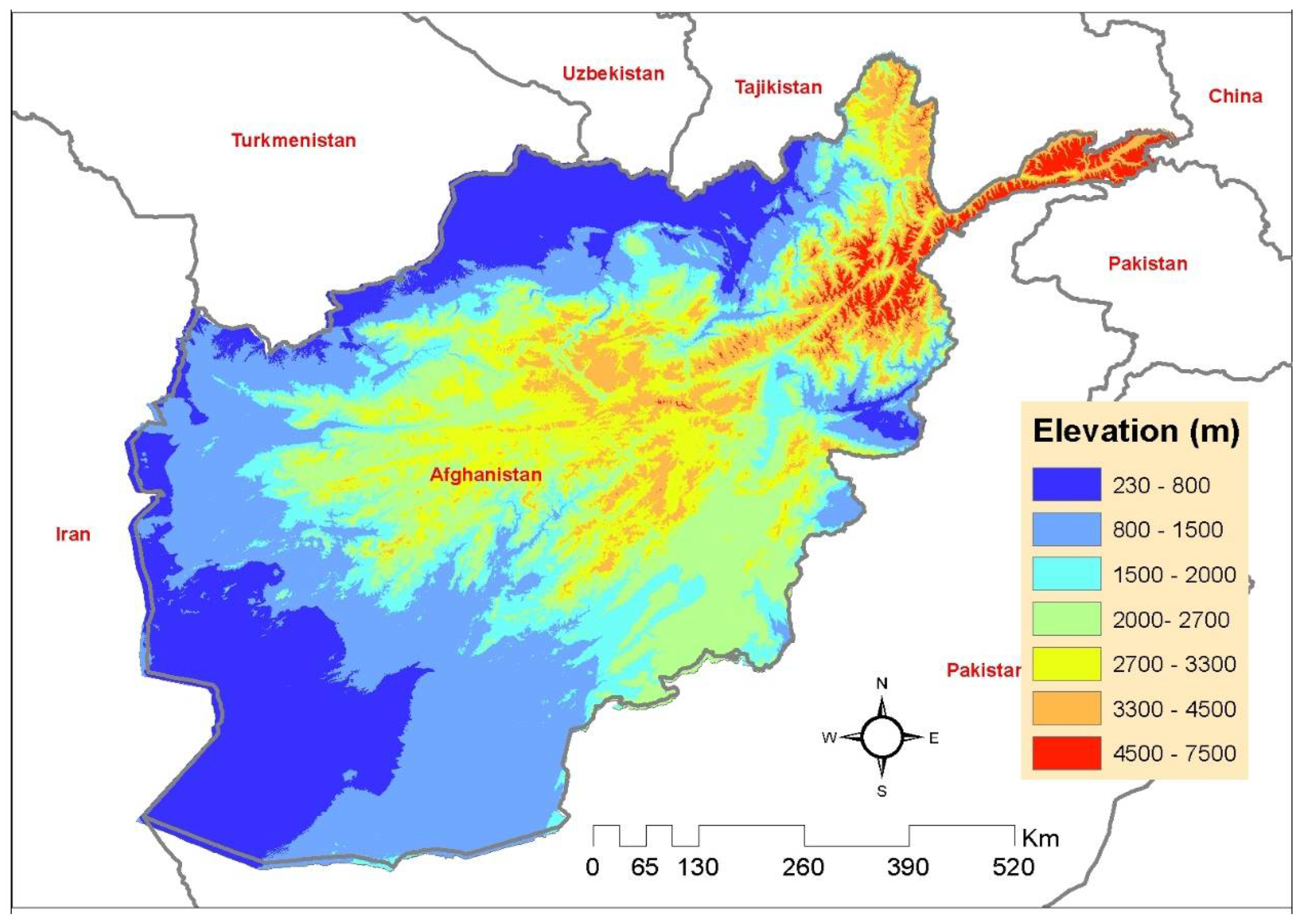

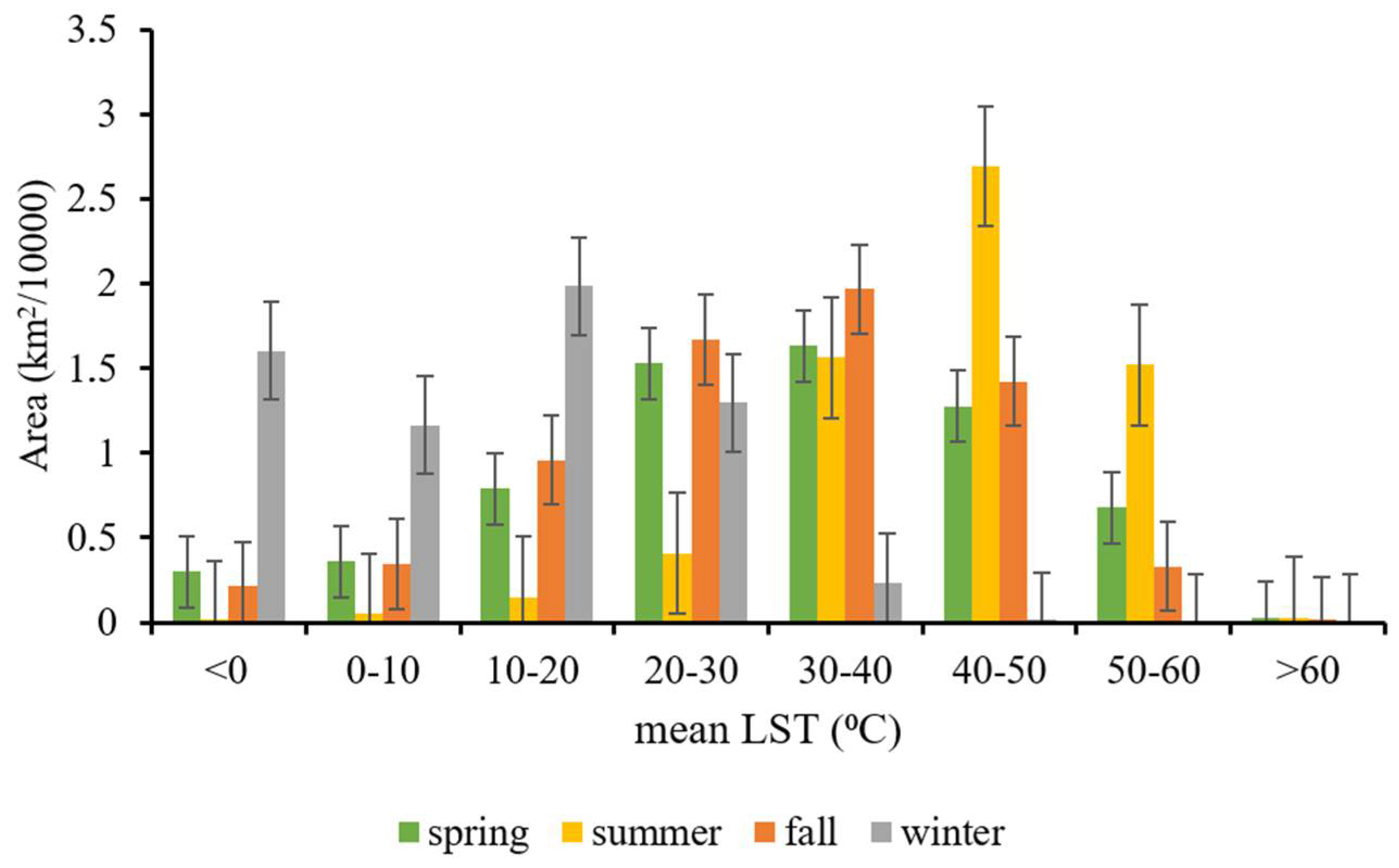
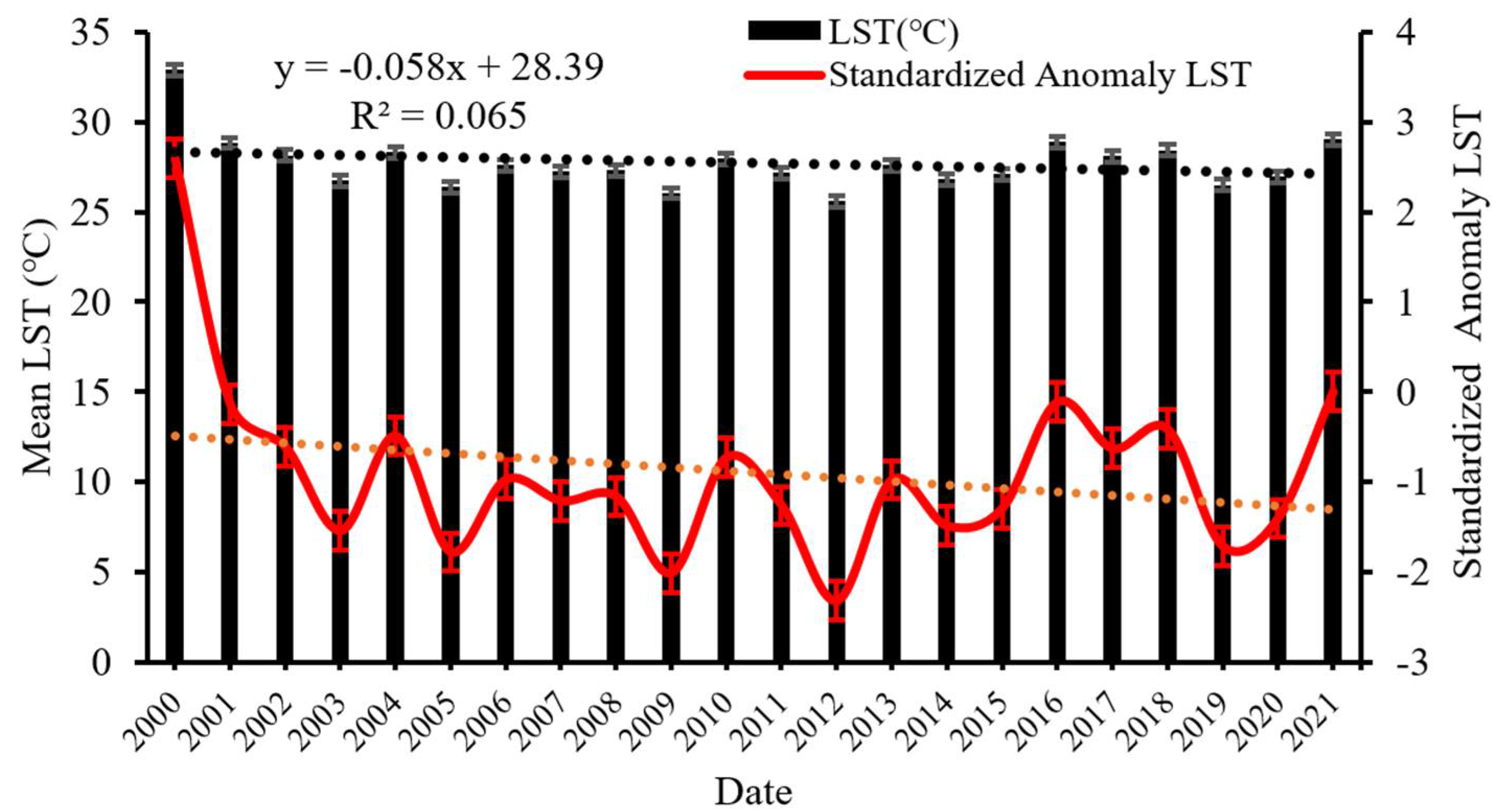
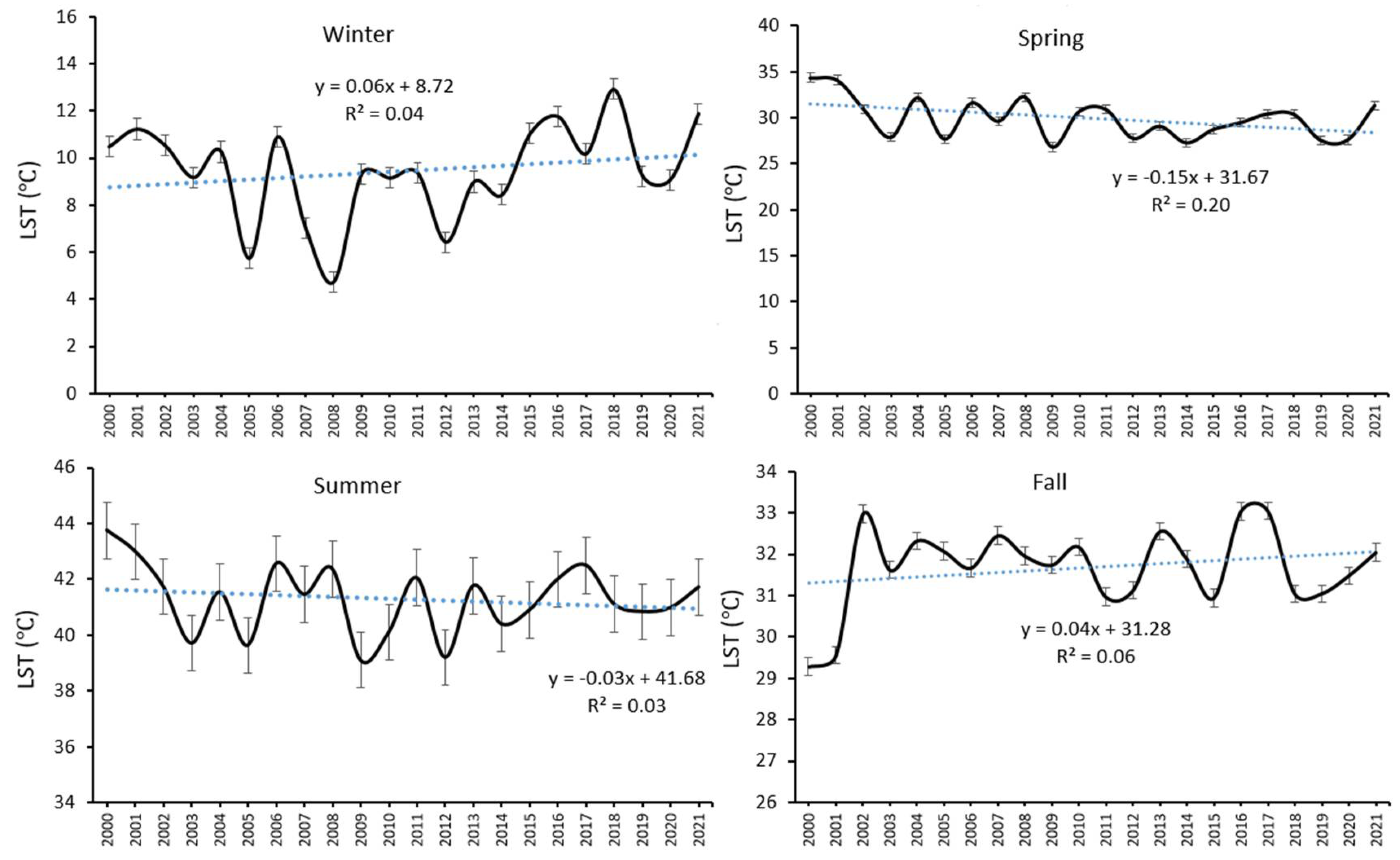
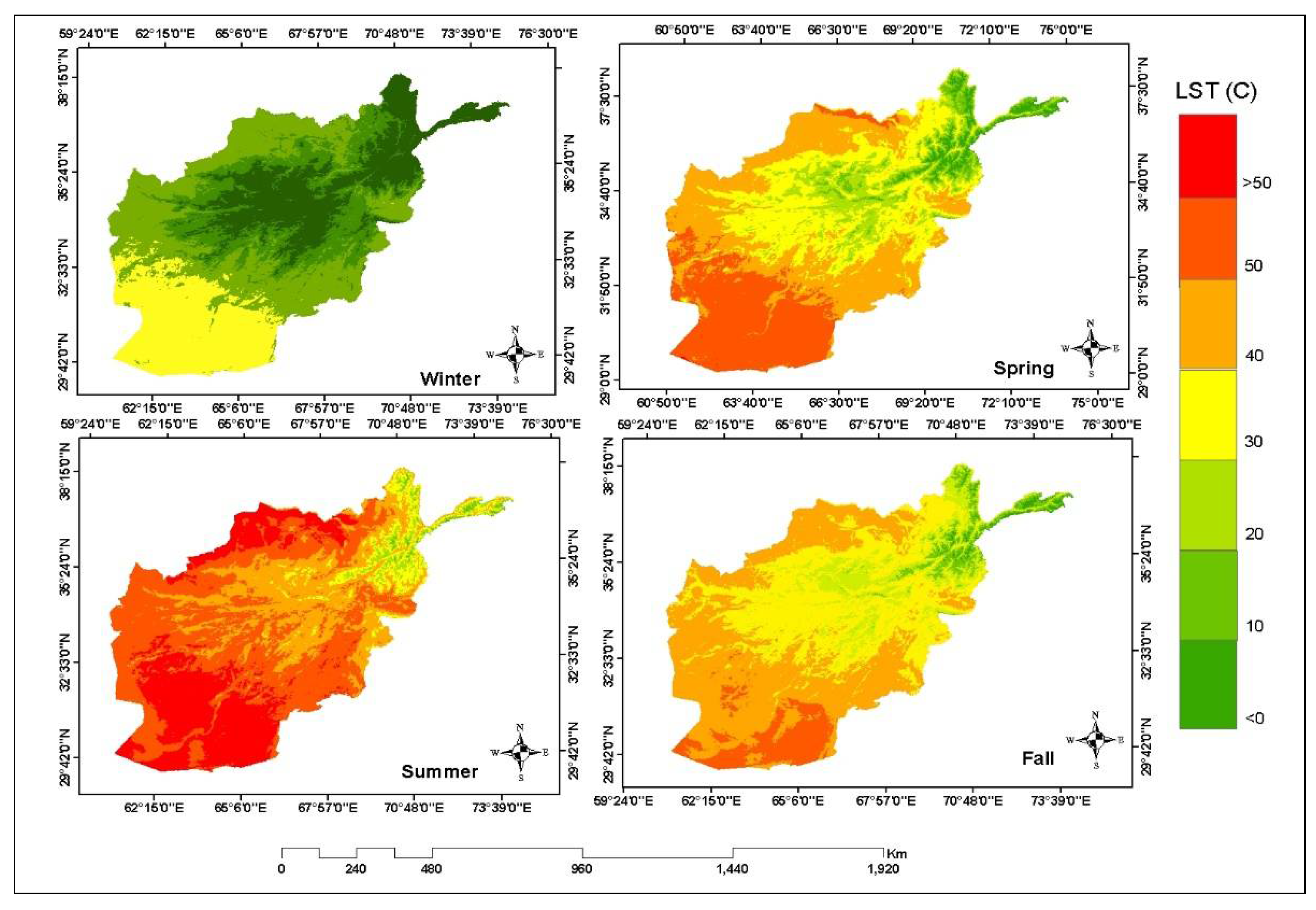
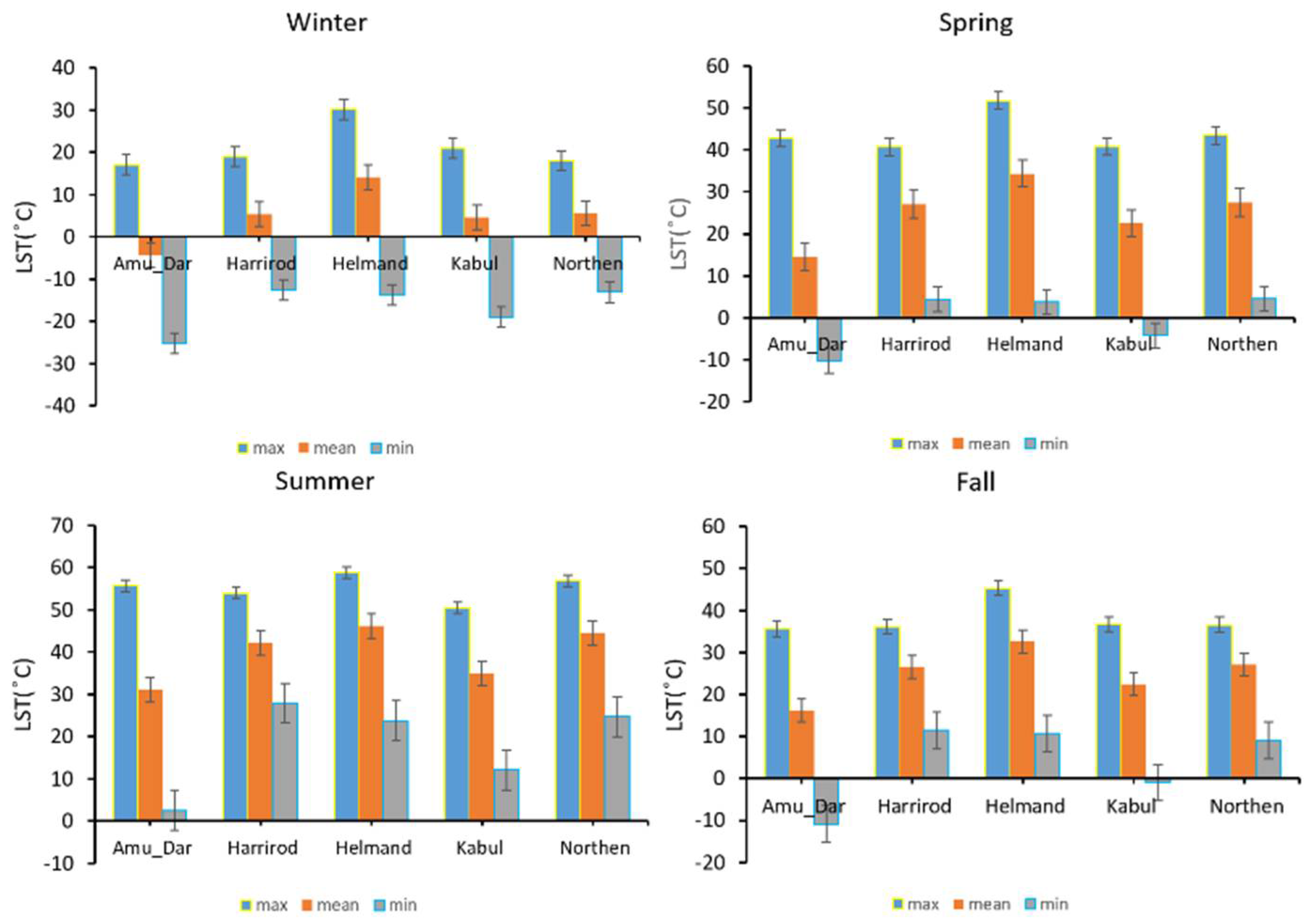

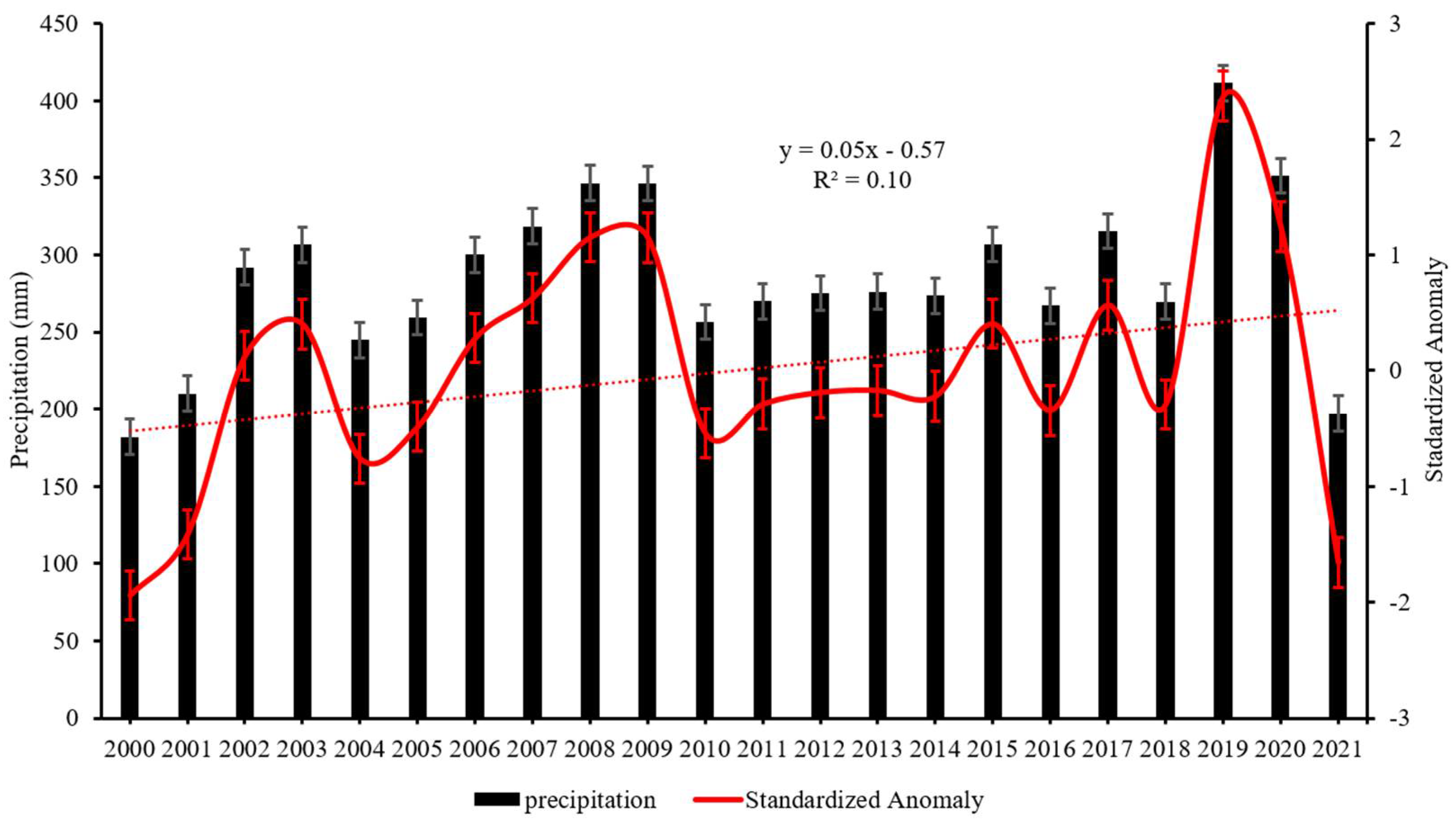
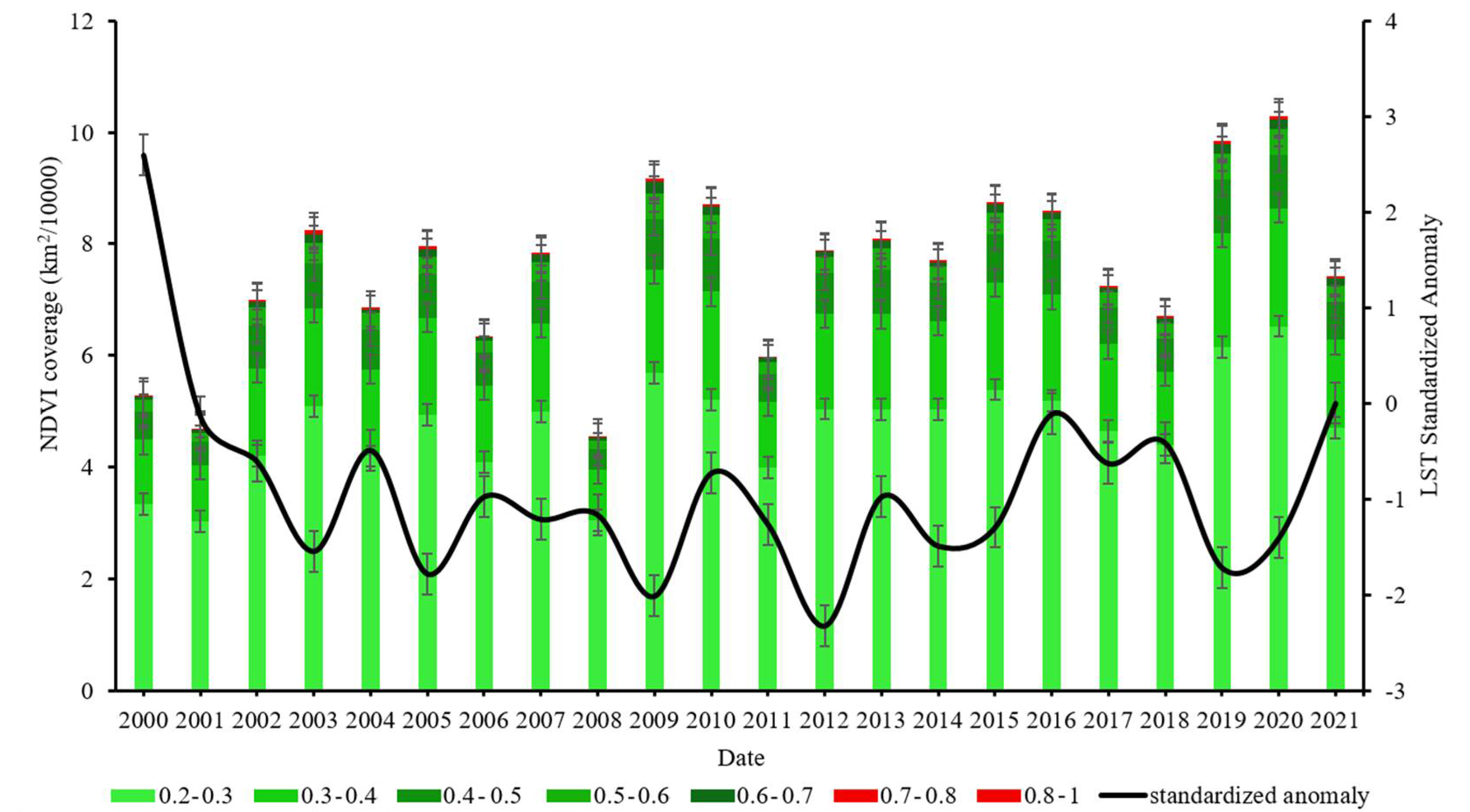
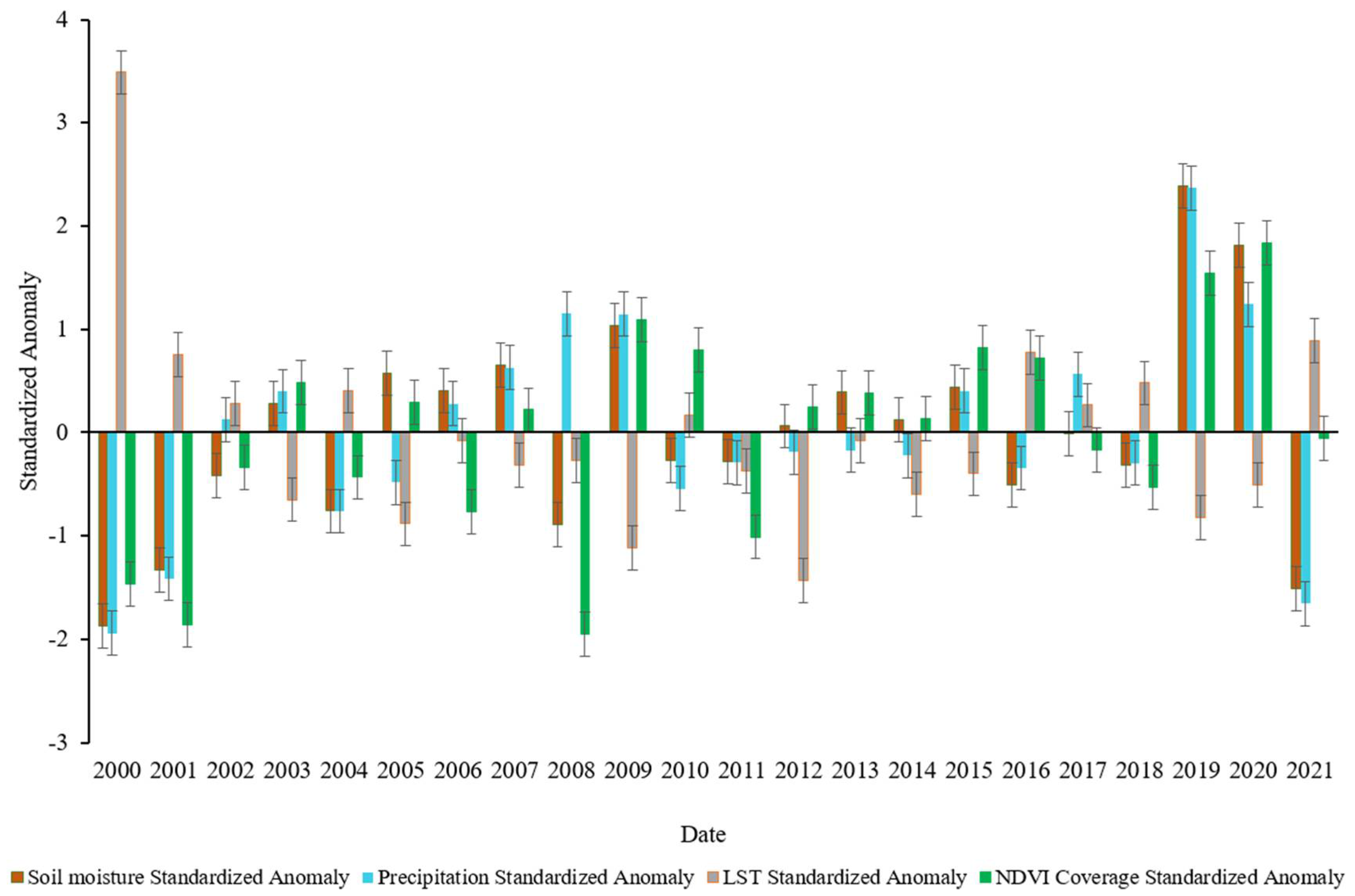
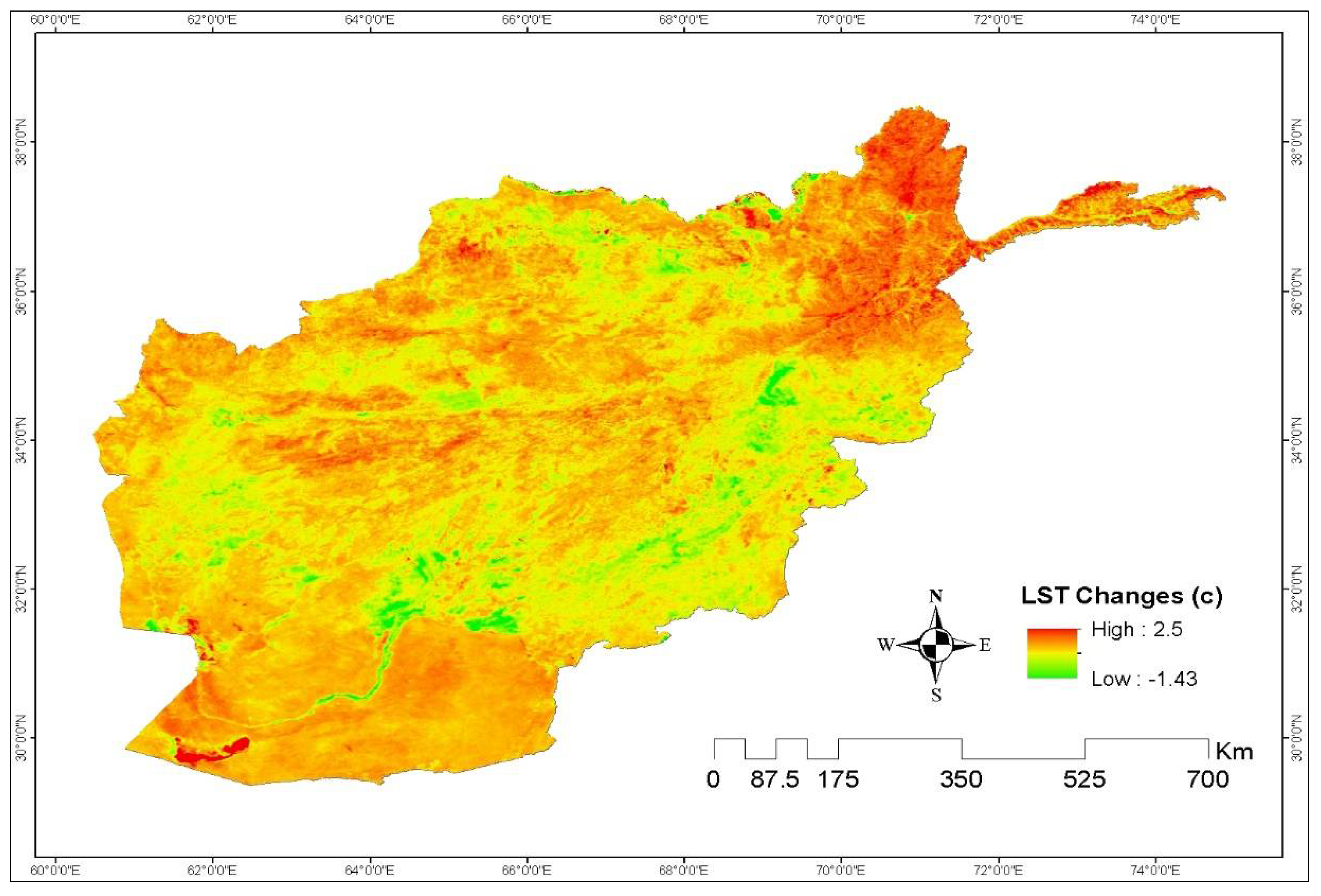

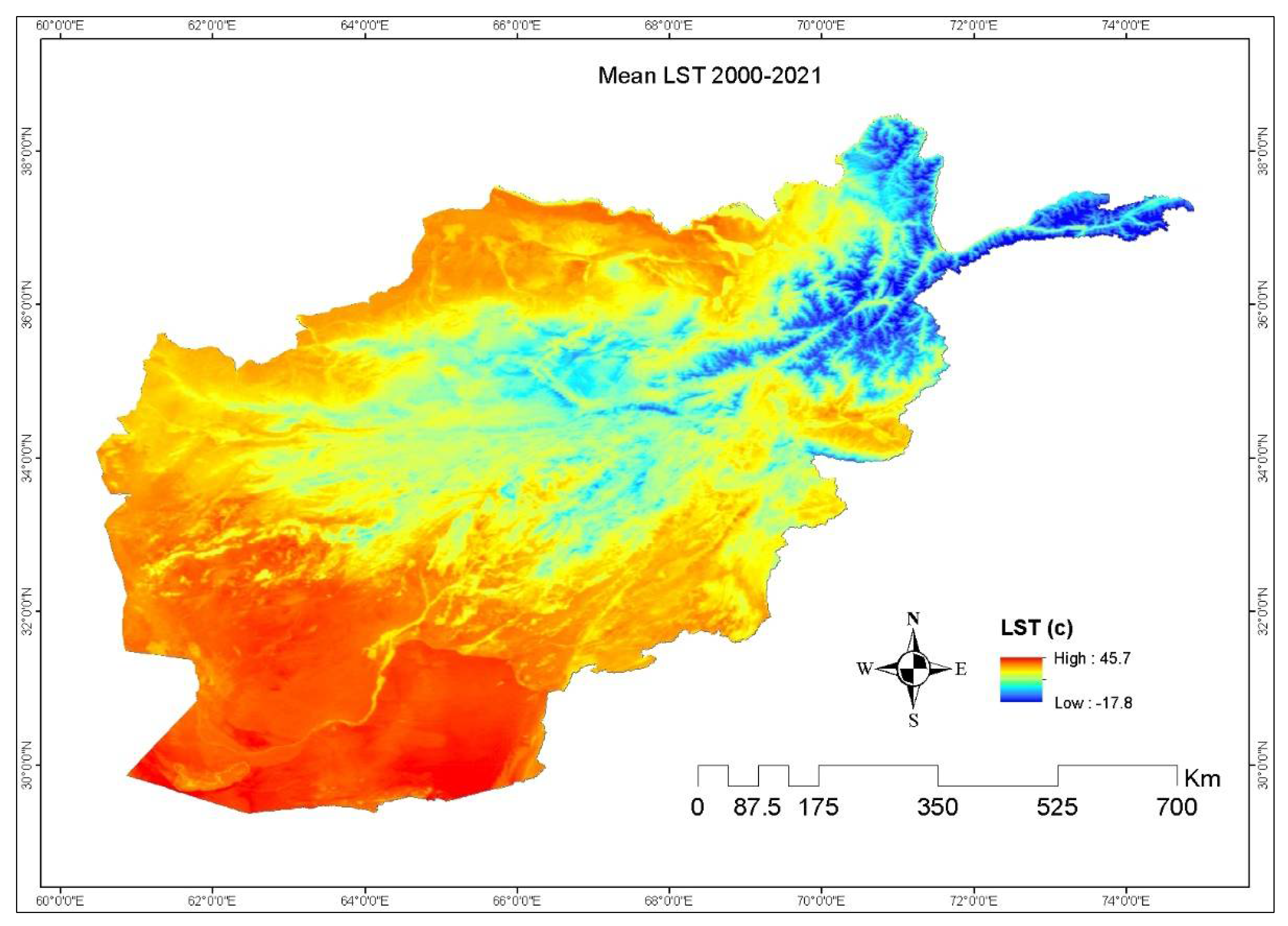
| No | Data | Source | Spatial Resolution | Temporal Resolution | File Format |
|---|---|---|---|---|---|
| 1 | MODIS Land Surface Temperature (MOD11A2) | MODIS packages in GEE | 1 km | 8 days | Geo tif |
| 2 | Normalized Difference Vegetation Index (MOD13Q1) | MODIS packages in GEE | 250 m | 16 days | Geo tif |
| 3 | Climate Hazards Group Infra-Red Precipitation with Station data (CHIRPS) | CHIRPS packages in GEE | 0.05° (~5 km) | pentade | Geo tif |
| 4 | Monthly Soil moisture | FLDAS packages in GEE | 1° | 30 days | NC file |
| R2 | R | p-Value | |
|---|---|---|---|
| LST-precipitation | 0.433 | −0.658 * | 0.000867 |
| LST-soil moisture | 0.503 | −0.709 * | 0.000216 |
| LST-NDVI coverage | 0.114 | −0.339 | 0.122 |
| Model of LST | R (Regression Coefficient) | R2 (Determination Coefficient) | Multiple Regression Equations |
|---|---|---|---|
| yearly | 0.77 | 0.59 | LSTyearly = 47.2 − 0.000009∙VCyearly − 80.9∙SoilMoistureyearly − 0.004∙Precipyearly |
| winter | 0.55 | 0.30 | LSTwinter = 26.16 + 0.000038∙VCwinter − 74.35∙SoilMoisturewinter + 0.022∙Precipwinter |
| spring | 0.86 | 0.73 | LSTspring = 49.44 − 0.000009∙VCspring − 66.6∙SoilMoisturespring − 0.0068∙Precipspring |
| summer | 0.87 | 0.76 | LSTsummer = 67.41 − 0.000031∙VCsummer − 163.2∙SoilMoisturesummer + 0.22∙Precipsummer |
| fall | 0.46 | 0.21 | LSTfall = 39.6 + 0.000034∙VCfall − 52.08∙SoilMoisturefall − 0.007∙Precipfall |
Publisher’s Note: MDPI stays neutral with regard to jurisdictional claims in published maps and institutional affiliations. |
© 2022 by the authors. Licensee MDPI, Basel, Switzerland. This article is an open access article distributed under the terms and conditions of the Creative Commons Attribution (CC BY) license (https://creativecommons.org/licenses/by/4.0/).
Share and Cite
Nabizada, A.F.; Rousta, I.; Dalvi, M.; Olafsson, H.; Siedliska, A.; Baranowski, P.; Krzyszczak, J. Spatial and Temporal Assessment of Remotely Sensed Land Surface Temperature Variability in Afghanistan during 2000–2021. Climate 2022, 10, 111. https://doi.org/10.3390/cli10070111
Nabizada AF, Rousta I, Dalvi M, Olafsson H, Siedliska A, Baranowski P, Krzyszczak J. Spatial and Temporal Assessment of Remotely Sensed Land Surface Temperature Variability in Afghanistan during 2000–2021. Climate. 2022; 10(7):111. https://doi.org/10.3390/cli10070111
Chicago/Turabian StyleNabizada, Ahmad Farid, Iman Rousta, Marjan Dalvi, Haraldur Olafsson, Anna Siedliska, Piotr Baranowski, and Jaromir Krzyszczak. 2022. "Spatial and Temporal Assessment of Remotely Sensed Land Surface Temperature Variability in Afghanistan during 2000–2021" Climate 10, no. 7: 111. https://doi.org/10.3390/cli10070111
APA StyleNabizada, A. F., Rousta, I., Dalvi, M., Olafsson, H., Siedliska, A., Baranowski, P., & Krzyszczak, J. (2022). Spatial and Temporal Assessment of Remotely Sensed Land Surface Temperature Variability in Afghanistan during 2000–2021. Climate, 10(7), 111. https://doi.org/10.3390/cli10070111








